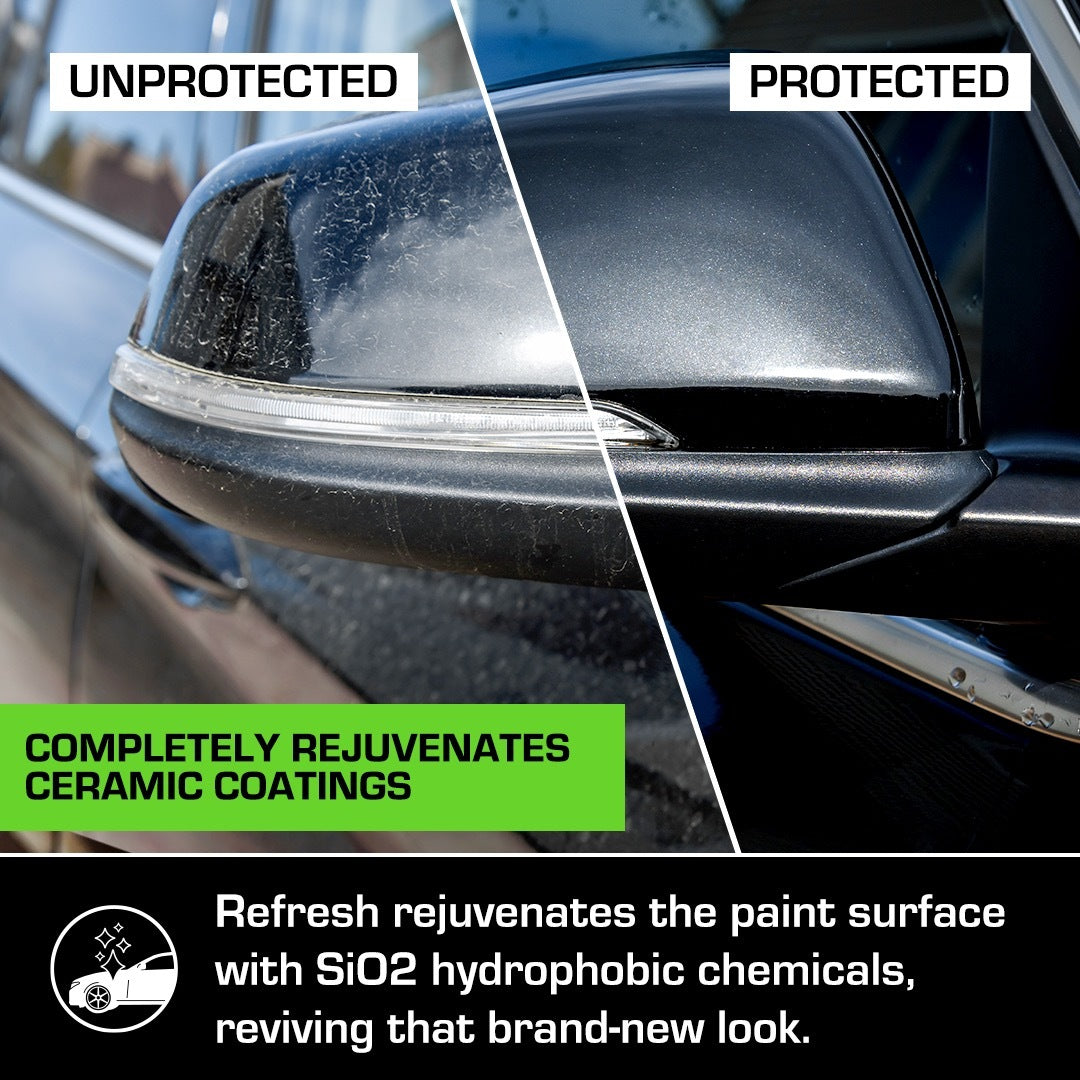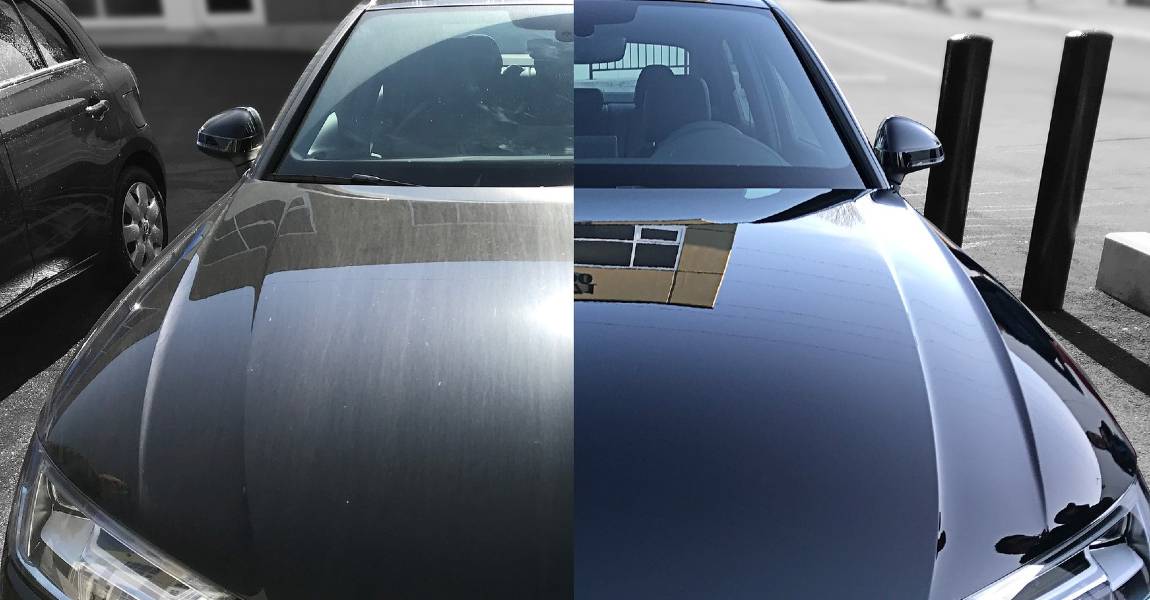Protect your car’s paint with Ceramic Coating Newark — here’s how
Wiki Article
Exploring the Scientific Research Behind Car Ceramic Coating and Its Safety Qualities
The science of car ceramic coating presents an interesting research in advanced auto protection. Composed largely of silicon dioxide and polymers, these coverings create a durable bond with automobile paint. This interaction improves longevity versus ecological hazards while using hydrophobic benefits. The complexities of how these coverings job and their lasting advantages stay less recognized. Ceramic Coating Newark. Unloading these information reveals why ceramic coatings are becoming a favored choice for vehicle treatmentWhat Is Ceramic Coating?
Ceramic coating is a liquid polymer that chemically bonds to the surface area of a car's paint. This innovative protective layer enhances sturdiness and provides premium resistance to ecological variables. Unlike typical wax or sealers, which offer short-lived security, ceramic layers produce a lasting shield that can endure severe conditions such as UV rays, acidic impurities, and severe weather. When used correctly, the coating creates a hydrophobic surface, causing water to bead and slide off, which aids in maintaining the vehicle's sanitation. In addition, it uses boosted gloss and depth to the paint, making the vehicle show up more refined and dynamic. The application process typically involves extensive surface preparation, including cleansing and polishing, to guarantee peak bonding. Therefore, ceramic layers are coming to be progressively preferred among car enthusiasts and those seeking to safeguard their investments, guaranteeing to preserve the automobile's visual appeal while reducing the frequency of maintenance.The Composition of Ceramic Coatings
The complex formula of ceramic layers largely includes silicon dioxide (SiO2), which is originated from natural sources like quartz and sand. This essential component provides the foundation for the coating's durability and protective high qualities. Along with SiO2, ceramic finishes frequently include numerous polymers and ingredients that improve adhesion, flexibility, and resistance to ecological variables. These compounds work synergistically to develop a robust obstacle against pollutants such as dust, chemicals, and UV rays.Furthermore, some formulations integrate titanium dioxide (TiO2) or other nanomaterials, which can increase the coating's hydrophobic properties, causing enhanced water repellency. The precise structure can differ significantly amongst producers, affecting performance and durability. Eventually, the mix of these elements culminates in a protective layer that not just enhances the visual allure of vehicles however also serves to prolong their life-span by shielding the surface from possible damages.How Ceramic Coatings Job
Comprehending just how ceramic coatings function entails exploring their chemical structure, which adds to their protective high qualities. The application process is vital for accomplishing ideal outcomes, while long life and sturdiness factors determine the coating's efficiency in time. With each other, these elements highlight the advantages and efficiency of ceramic coverings for lorry protection.Chemical Structure Explained
While lots of car proprietors seek durable security for their vehicles, the chemical composition of ceramic layers plays an important function in their performance. These coverings primarily include silicon dioxide (SiO2), which is stemmed from natural minerals. This compound creates a solid bond with the lorry's paint, creating a durable, safety layer. Additionally, lots of ceramic finishes contain titanium dioxide (TiO2), boosting their hydrophobic buildings and resistance to UV rays. The presence of polysiloxanes can better improve adaptability and longevity. Together, these components add to the coating's ability to push back water, dirt, and contaminants, while likewise providing a high-gloss coating. Comprehending this chemical foundation assists car owners appreciate the durable security provided by ceramic coatings.Application Refine Introduction
Applying ceramic layers includes a careful procedure that guarantees suitable bonding and defense for the car's surface area. Originally, thorough cleaning and purification of the car's outside are performed to eliminate dust, grime, and previous waxes. This step validates that the surface is free from contaminations that might prevent attachment. Following this, the paint is typically brightened to boost clarity and get rid of any type of flaws. As soon as prepared, the ceramic coating is used in small areas utilizing an applicator pad, permitting consistent protection. The coating is after that delegated cure, developing a solid chemical bond with the surface. Correct curing times and conditions are important, as they validate the coating accomplishes its maximum efficiency and protective qualities.Longevity and Longevity Elements
Ceramic coatings are created to provide resilient protection with their innovative chemical structure, which creates a robust barrier against ecological impurities. The longevity of these layers is influenced by elements such as the density of the application, the quality of the item, and the conditions under which the vehicle is revealed. High-grade ceramic layers can last several years, resisting scrapes, UV rays, and chemical discolorations. Correct maintenance, consisting of normal cleaning and regular reapplication, can better enhance longevity. In addition, ecological aspects like climate and exposure to toxins can affect the life-span of the coating. Generally, when applied and preserved appropriately, ceramic finishings provide extraordinary toughness, making them a prominent option for car enthusiasts seeking to preserve their automobile's appearance.Hydrophobic Features and Water Repellency
Hydrophobic buildings are a characteristic of high quality car ceramic finishings, considerably boosting the vehicle's surface area performance. These coatings create a molecular bond with the car's paint, causing a surface that pushes back water efficiently. When water enters into contact with a ceramic-coated surface area, it beads up and rolls off, reducing the quantity of fluid that remains on the paint. This actions not just adds to a visually pleasing look however also lowers the accumulation of pollutants such as dust, gunk, and roadway salts.The improved water repellency results in less complicated cleaning and maintenance, as much less initiative is called for to get rid of unwanted substances. On top of that, the hydrophobic nature of ceramic coatings assists in stopping water places, which can mar the coating of uncoated surface areas. Generally, the unification of hydrophobic residential or commercial properties in ceramic finishings plays a crucial duty in preserving the automobile's beautiful look while streamlining upkeep.Security Against Scratches and UV Damages
Car ceramic coverings offer substantial security against scrapes and UV damages. The scrape resistance system develops a sturdy layer that soaks up influences, while the UV securing advantages aid keep the vehicle's paint honesty in time. Together, these functions add to a longer-lasting and aesthetically appealing surface.Scrape Resistance Device
Making use of innovative technology, ceramic layers give a robust guard against scratches and UV damages, improving the longevity and look of car surface areas. The scrape resistance device of these finishes is credited to their one-of-a-kind molecular framework, which develops a long lasting bond with the lorry's paint. This bond creates a hard, safety layer that can soak up influences and withstand abrasions. Furthermore, the smooth resource surface area of the coating reduces friction, making it tough for pollutants to adhere and cause scratches. The chemical make-up of ceramic layers commonly includes nanoparticles that enhance the protective layer, more improving its durability. As a result, cars treated with ceramic finishes display noticeably improved scratch resistance contrasted to standard wax or sealants, making sure a pristine surface over time.UV Protecting Benefits
The safety top qualities of ceramic coverings extend beyond scratch resistance to consist of considerable UV securing benefits. look at this now These coverings create a durable obstacle that mirrors dangerous ultraviolet rays, protecting the automobile's paint and underlying materials. Prolonged exposure to UV radiation can bring about fading, oxidation, and degeneration of the paint coating. By integrating ceramic layers, automobile owners can successfully alleviate these dangers, preserving the visual charm and honesty of their cars. Furthermore, the UV obstructing residential properties add to improved long life, minimizing the regularity of repainting and upkeep. Eventually, the assimilation of ceramic finishings offers a detailed service for shielding automobiles from the damaging results of sun direct exposure, making sure a continual, vibrant look over time.The Longevity and Maintenance of Ceramic Coatings

Frequently Asked Concerns
Can Ceramic Coating Be Applied to Any Type Of Sort Of Vehicle?
Ceramic coating can be put on different kinds of vehicles, consisting of cars and trucks, vehicles, and motorcycles. Surface prep work and compatibility with particular products are essential for suitable adhesion and effectiveness of the coating.Just How Much Does Ceramic Coating Commonly Expense?
Ceramic coating typically costs in between $500 and $2,000, relying on elements such as lorry dimension, coating high quality, and specialist application. The financial investment can provide long-lasting defense and enhance the lorry's appearance over time.
Is Expert Application Essential for Best Outcomes?
The need of professional application typically depends upon wanted outcomes. Specialists typically guarantee correct surface area prep work and application methods, causing optimal bonding and longevity of the coating, which might be challenging for inexperienced Get More Information individuals to attain.Can Ceramic Coatings Be Gotten Rid Of or Repaired?
Ceramic finishings can be gotten rid of or fixed, though the process may need details solvents or methods - Ceramic Coating Newark. Correct elimination is necessary to avoid damages to the underlying surface area, emphasizing the importance of expert assistance for suitable resultsJust How Does Ceramic Coating Contrast to Conventional Wax?
The contrast between ceramic coating and typical wax exposes that ceramic coatings use superior longevity, improved defense versus ecological pollutants, and longer-lasting shine, while wax needs much more constant application and offers much less general resistance to damages.Report this wiki page